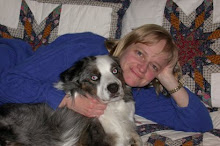
Yesterday, our Golden Retriever, Bella, was watching out one of our windows as a couple of neighbor kids were playing on their jungle gym. You could tell she had spotted them since she stood really still and her ears were perked forward. Also, her tail was still and just turned toward her left side, just a little. When my daughter, Sarah, called Bella's name, her tail then swung to the right. (No, there are no political jokes here!) That reminded me of something I had seen on TV some time ago. I don't remember exactly where I saw it, but I think it was on the National Geographic channel and it was a special about dogs. The program was talking about how the direction a dog's tail wags tells you a lot about how the dog is feeling.
I decided to try to find out more about this phenomenon. It took awhile. There is a lot of information about a dog's tail wagging in general and how they carry it. I tried Googling various keywords like "Dog Tail Carriage Recognition" because part of the story was that the dog would put it's tail to the right if it recognized it's owner. I finally found it when I Googled "Study Dog Tail Recognition".
One of the articles I found is from the New York Times. The study is called, "Asymmetric Tail-wagging Responses by Dogs to Different Emotive Stimuli." Some researchers in Italy put volunteer dogs in crates with cameras above their hind-quarters to record what would happen when the dogs saw different things: their owner, an unfamiliar human, a cat, and a unfamiliar dominant dog.
This was the results from the New York Times:
When the dogs saw their owners, their tails all wagged vigorously with a bias to the right side of their bodies, Dr. Vallortigara said. Their tails wagged moderately, again more to the right, when faced with an unfamiliar human. Looking at the cat, a four-year-old male whose owners volunteered him for the experiment, the dogs’ tails again wagged more to the right but in a lower amplitude.Click on the multimedia clip on the Times Page as well. It gives you a real feel for what the study shows.
When the dogs looked at an aggressive, unfamiliar dog — a large Belgian shepherd Malinois — their tails all wagged with a bias to the left side of their bodies.
Thus when dogs were attracted to something, including a benign, approachable cat, their tails wagged right, and when they were fearful, their tails went left, Dr. Vallortigara said. It suggests that the muscles in the right side of the tail reflect positive emotions while the muscles in the left side express negative ones.
Our other dog is Smokey, the Australian Shepherd. He has a little stubby tail, so watching it won't tell us much. But he does wiggle his whole rear-end when he gets excited, so we are going to watch and see if his rear-end goes one way or the other.
Dogs are so entertaining!




I can just picture the three of you watching Smokey to see which way her rear wags! LOL Interesting, though. Now I'll have to pay attention to the tails of Indy and Wylie.
ReplyDeleteSmokey's whole body curves to the right when the alpha dog comes home.
ReplyDelete